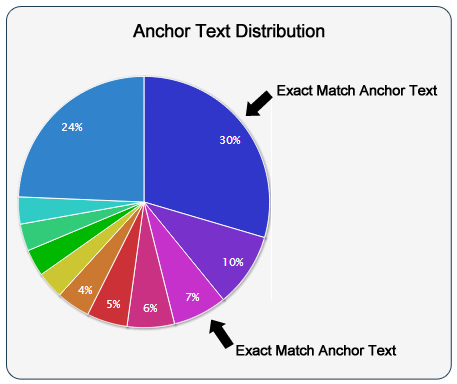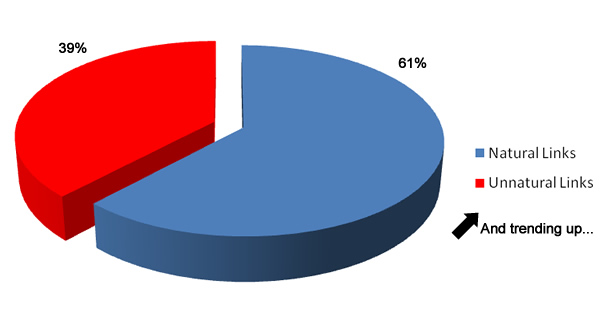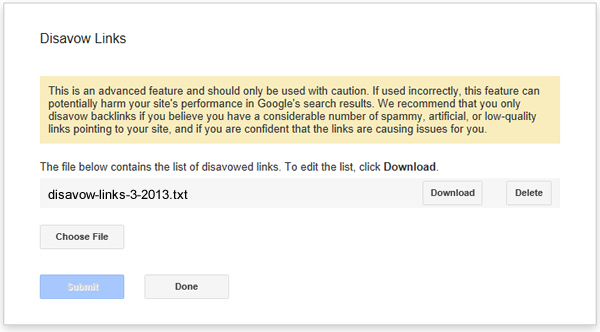
I’ve completed a lot of Penguin work since April 24, 2012 (more than I ever wanted to if I’m being honest).
When business owners first reach out to me about a Penguin hit, their emails can be hard to get through. You can hear the pain, frustration, and confusion come through in their writing. “Our traffic dropped off a cliff”, “we started laying people off”, “we have no idea where to start”, “we will probably go out of business”, etc.
Most Penguin work is reactive, where companies respond to a severe drop in traffic and try to recover. They didn’t see Penguin coming, and then BAM, they got hit square in the face.
It isn’t often you get a call from a company that turns into a proactive Penguin project. But that’s exactly what happened this past February, when I helped a company with a troubling unnatural link situation prior to its website getting hit by Penguin (or a manual penalty).
From Website Redesigns to WOT to Unnatural Links
There’s a business owner I’ve known for about a year now, and he contacted me in February about an approaching website redesign. From our initial conversations (last year), he remembered when I explained how dangerous a website redesign could be SEO-wise. So, when he was approaching the launch of the redesign in early February, he contacted me to see if I could help him prepare.
But that wasn’t all he explained. He told me how some of his friends were seeing warnings from web of trust (WOT) that his site had a poor reputation score. He had no idea why that was happening and thought I might be able to help.
What happened next was eye opening. And for the business owner, his poor WOT score was just the tip of the iceberg.
Web of Trust (WOT) and Human Intelligence
If you’re not familiar with web of trust (WOT), it’s a crowdsourced system for rating and monitoring “trust” across the web. Think of it like McAfee’s site advisor, but focused on fighting spam and scams versus viruses and malware. Most of the data collected via WOT is from human raters.
Based on the website’s low reputation score, I decided to take a look for myself. Upon digging into the ratings, I noticed a review that said, “profile link spam”. As soon as I saw that, my first thought jumped to comment spam, unnatural links, and Penguin. Yes, that’s unfortunately how I think now. This was the first sign of a link issue, and I had to learn more.

Now, I know this person fairly well. He’s as honest as they come, and he has incredibly strong integrity. I thought to myself, was he using comment spam to gain exact match anchor text links? No way! That was hard for me to believe. I had to know what was going on, so it was time to analyze his link profile.
Link Analysis – The Infiltration of Bad Links
So, I asked for access to Google Webmaster Tools so I could check out the inbound links that Google had picked up. Unfortunately, the business owner didn’t have an account set up.
Lesson 1 for anyone new to SEO: set up your Google Webmaster Tools account and verify your website today. There’s a boatload of important data that Google shares with webmasters, including inbound links.
So, I shot over to Majestic SEO and Open Site Explorer to analyze his link profile. Although both tools did not show all of the site’s links, it didn’t take long to see a relatively big unnatural link problem. I quickly noticed exact match anchor text for competitive keywords related to his business (at the top of the anchor text list). I drilled into those links and noticed many Penguin-like links. They were exactly the types of links I’ve seen a thousand times while analyzing sites hit by Penguin. For example, exact match anchor text links in blogrolls, comment spam, directory links, etc.

And when I finally had access to Google Webmaster Tools, the problem became worse. Google was showing more links to the site overall, including more spammy links than what showed up in OSE and Majestic.
Google Webmaster Tools revealed that spammy links now accounted for approximately 40 percent of his link profile (and as I found out over time, the number of spammy links was trending up). It was time to call my contact and explain what I found.

Lesson 2: Don’t put off developing a content strategy, social strategy, and link building plan. Great content and a strong social strategy can go a long way to developing a natural, well-balanced link profile. This website, like many small business websites, had not built up a lot of natural links. That put the site at risk, especially when situations like this arise.
Hunting Down the Root Cause of Unnatural Links
I called the business owner and started asking questions. “Have you done any SEO work over the past few months?” He shot back with a split-second response, “No way. I haven’t done a single thing.”
Then I asked if he launched any link building efforts for his site. Another quick response, “No, I’ve focused my attention on my YouTube channel and not my website. I wanted you to help with SEO for the site. Glenn, what’s going on?”
I have to admit, I was thrilled to hear his response. I never thought he would engage in spammy link activity, but I’ve seen so many crazy examples over the past year, that I had to ask.
So, I proceeded to share my screen and show him example after example of the spammy links I uncovered. Our webcams weren’t on at the time, but I could feel his shock and anger through his voice. He was truly floored with the evidence I was presenting. And he kept saying, “Who would set these up?” Good question, and one we would tackle next.
Examples of unnatural links uncovered:


Negative SEO?
I asked my contact again if anyone on his team, or if any vendors, had been building links. Again, a quick “No” was the response. So, if the business owner and his team didn’t build any of the spammy links, and a third party didn’t either, then how in the world did the links get set up? I could only think of one thing: negative SEO. Someone must be targeting the business.
Detective Work Begins
I started visiting all the pages that contained spammy links to the website (collected from Google Webmaster Tools, Majestic, and OSE.) About 30 minutes into my analysis, I stopped and thought it might be better to first rule out all parties that worked on the website over the past year. I wasn’t convinced this was negative SEO.
So I called the business owner back and asked him to run through an exercise for me. I asked him to list every person that helped him with his website over the past 12 months. Then I helped him craft an email to those people explaining the current link situation, how it could eventually hurt his website, and that we were racing the next Penguin update. The emails were sent out the same day we spoke.
The Trusted Third Party, and the Untrusted Fourth Party
Email responses started coming in. There were many denials, and you could tell they were genuine. And then a response came in from a company that had helped my client for some time… and it was exactly the response we were looking for.
That company was helping promote some of my client’s services and ended up launching a campaign in the fall of 2012. And as part of that campaign, the company decided to build links to my client’s website to “increase the visibility” of his services. Yes, those were the spammy links I picked up in my analysis. And the business owner had no idea this was going on.
It ends up that company outsourced link building to a handful of consultants (overseas). Those consultants ended up building exact match anchor text links in spammy directories, in blogrolls on spammy blogs, and via comment spam. Again, the links were prototypical Penguin food. I’ve seen them thousands of times since April 24, 2012 when Penguin first hit.

Now that we knew how the links were set up, and who set them up, we were ready to form a plan of attack. We reached back out to the company that set up the links and spoke with a vice president about next steps.
Stepping Up and Taking Responsibility
My client (the small business owner) explained the situation to the vice president in detail, while I explained more about Penguin, unnatural links, etc. I also showed several screenshots of Google organic trending for sites hit by Penguin. We emphasized that we did not want my client’s site getting hit by Penguin, or a manual penalty, based on the links that were built by his company. I also explained that an official Penguin update hadn’t been launched since October 5th, 2012, and that we were essentially racing Penguin. We needed help taking down the links ASAP.
A (Penguin) picture is worth a thousand words:

Our contact at the company was straightforward, apologetic, and moved fast. This was awesome, since I’ve seen many situations where link building companies, agencies, etc. would not move fast (or would require payment to have links removed). The vice president of the company was completely stepping up, taking responsibility, and moving quickly.
He worked through the weekend contacting the link builders they used about taking down the spammy links. Within a day, we heard back that some of the links were already coming down. We had a number of spreadsheets going back and forth, with worksheets containing links that were flagged, links being taken down, and others that couldn’t be taken down.
In addition, our contact always gave us realistic goals timing-wise about when the links would be coming down. He was also straightforward when they couldn’t be taken down. And for links we couldn’t get taken down, I always knew we had the disavow tool as a last resort.
Disavow Tool and Reconsideration Requests
Within a week, we were in much better shape than we had been. A good percentage of links were taken down, and more takedowns were on the way. The remaining links that couldn’t be taken down were added to my disavow worksheet.
Although we worked hard on taking down many of the spammy links, there were some that just couldn’t be removed. And that’s a perfect use for the disavow tool. So I submitted the disavow file via Google Webmaster Tools and then worked with the business owner on crafting a reconsideration request.

A Detailed and Genuine Reconsideration Request
For the reconsideration request, I told the business owner to write up the situation in his own words. He explained the full story, including how we found the links, how his vendor set them up, how we went about removing them, and then how we used the disavow tool for any links we couldn’t remove manually. We also linked to a spreadsheet containing all of the links we addressed, which ones were removed, and which ones we disavowed.
And the best part of the reconsideration request was the section from the vice president of the company that set up the spammy links. He felt horrible about the situation and absolutely wanted to explain to Google that my contact had nothing to do with the links. He wrote a few paragraphs explaining what happened, and he provided his full signature, including email address and phone number. He stepped up, took responsibility, and did the right thing.
Current Status
During this process, I kept a close eye on the website via Google Webmaster Tools, Google Analytics, and via third-party link analysis tools. I wanted to know if any changes impacted the site from a rankings or traffic standpoint. The website was fine throughout the process, and my hope is that my contact is out of the woods Penguin-wise.

We won’t officially know how the website fares until the next Penguin update, but I’m confident the problem has been taken care of (on several levels). We removed many bad links, we disavowed a number of links that we couldn’t remove manually, and then we also filed a thorough reconsideration request detailing the situation (with a quote from the company that set up the bad links).
Lessons Learned and Key Insights for Webmasters
What started as quick email about WOT turned into a race against the mighty Penguin. There are definitely some important lessons from this case study that we wanted to share.
Let’s face it, this very well could be happening to thousands of unsuspecting companies across the world, so we hope these learnings can help some of them avoid disaster:
- Understand the Scope of Work: Fully understand the scope of work when you hire a third party. Ensure you know all the projects they will be tackling, and make sure you get the list in writing. Also, make sure you receive reporting that explains what has been completed. If you do, then you can easily check the work to make sure all is ok.
- Who Will Be Doing the Work?: Understand who is actually completing the work, and get it in writing. Don’t fall victim to companies outsourcing work to unknown consultants around the world. I’ve seen this scenario many times during my Penguin research, and it doesn’t end well.
- Set Up Google Webmaster Tools: For the love of SEO, set up your Google Webmaster Tools account and verify your website(s) today! Seriously, there are so many important pieces of data you gain access to via your account. And you can verify your site in just minutes. Do it now. Ditto for Bing Webmaster Tools.
- Analyze Your Inbound Links: Understand your link profile now. Don’t wait for a Penguin update to review your inbound links. Have a link analysis completed so you can understand which sites are linking to you, and how they are linking to you. You never know what you are going to find.
- Take Swift Action: If you find a problem, take action, move fast, and be thorough. Don’t just talk about the problem, attack it like you’re on a mission. And be as thorough as you can, both with link removals, and with your reconsideration request. And don’t be afraid to use the disavow tool as a last resort. That’s what it’s there for.
Approaching the Finish Line
Racing Penguin, like most Penguin work, isn’t fun. Again, most companies react to Penguin (as they see a massive drop in traffic after a Penguin update). It’s not often you find yourself racing Penguin to the finish line (or update line). But that’s exactly what we had to do.
My client’s site isn’t in the clear yet. We need another Penguin update to hit before we can truly feel comfortable.
In the meantime, my client is working on developing a solid content plan and social strategy. It’s something he’s needed to do for a while, and this situation has kicked that work into full gear. And that’s a good thing.
Now what was that about a poor WOT score?









